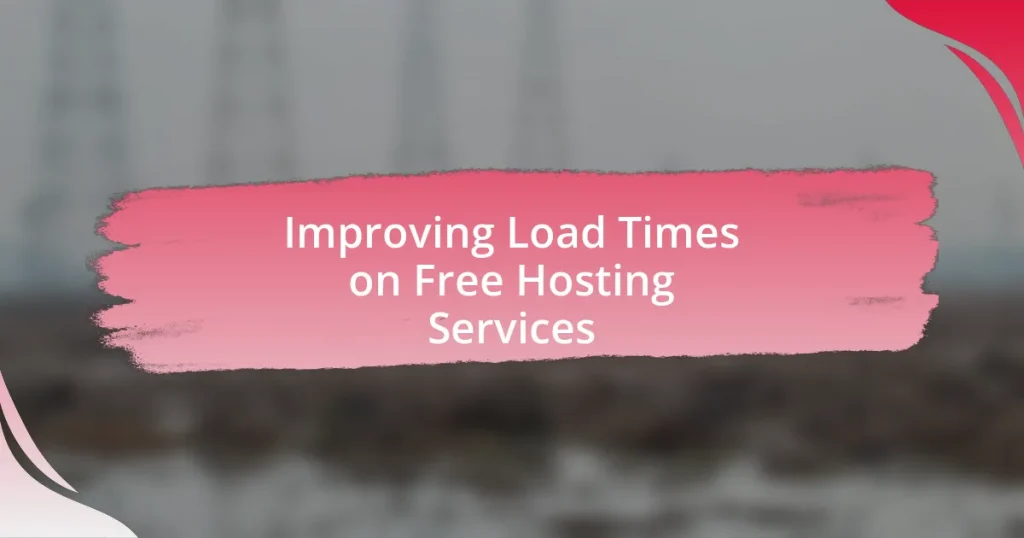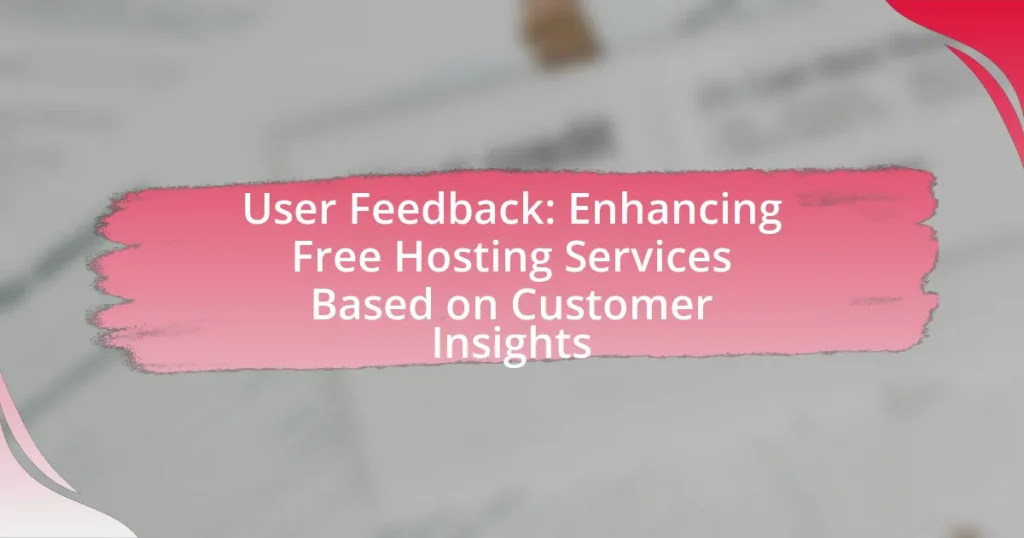Load times are a critical factor for free hosting services, as they directly influence user experience, engagement, and search engine rankings. This article explores the significance of load times, detailing how they affect user retention and satisfaction, and identifies key metrics for measuring performance. It also examines the factors contributing to slow load times, such as limited server resources and website design, while offering strategies for optimization, including image compression and caching techniques. Additionally, the article highlights tools for monitoring load times and best practices for maintaining optimal performance over time.

What are Load Times and Why are They Important for Free Hosting Services?
Load times refer to the duration it takes for a webpage to fully display its content after a user requests it. They are crucial for free hosting services because slow load times can lead to higher bounce rates, negatively impacting user experience and search engine rankings. Research indicates that a one-second delay in load time can reduce conversions by 7%, highlighting the importance of optimizing load times to retain visitors and enhance overall site performance.
How do load times affect user experience on free hosting services?
Load times significantly impact user experience on free hosting services by influencing user satisfaction and retention. Research indicates that a one-second delay in page load time can lead to a 7% reduction in conversions, highlighting the critical nature of speed in user engagement. Additionally, users are likely to abandon a website if it takes longer than three seconds to load, as shown in studies by Google. This abandonment can be particularly detrimental for free hosting services, where users often have limited patience and higher expectations for performance. Therefore, optimizing load times is essential for enhancing user experience and maintaining user interest in free hosting platforms.
What metrics are used to measure load times?
The primary metrics used to measure load times include Time to First Byte (TTFB), First Contentful Paint (FCP), and Fully Loaded Time. TTFB measures the time taken for the server to respond to a request, indicating server performance. FCP tracks the time it takes for the first piece of content to be rendered on the screen, reflecting user experience. Fully Loaded Time measures the total time taken for all page resources to load, providing a comprehensive view of load performance. These metrics are essential for assessing and optimizing website speed, as they directly impact user engagement and satisfaction.
Why is user retention influenced by load times?
User retention is influenced by load times because faster load times enhance user experience, leading to higher satisfaction and engagement. Research indicates that a one-second delay in page load time can result in a 7% reduction in conversions, as users are more likely to abandon slow-loading sites. Additionally, studies show that 53% of mobile users will leave a page that takes longer than three seconds to load. This correlation between load times and user behavior underscores the importance of optimizing performance to retain users effectively.
What factors contribute to slow load times on free hosting services?
Slow load times on free hosting services are primarily caused by limited server resources, high traffic volume, and lack of optimization. Free hosting providers often allocate minimal bandwidth and processing power to each user, which can lead to slower response times during peak usage. Additionally, these services may experience congestion due to multiple websites sharing the same server, further degrading performance. Studies indicate that websites hosted on free services can load significantly slower than those on paid plans, with load times exceeding 3 seconds in many cases, which can negatively impact user experience and SEO rankings.
How does server performance impact load times?
Server performance directly impacts load times by determining how quickly a server can process requests and deliver content to users. High-performance servers, characterized by faster CPUs, ample RAM, and optimized storage solutions, can handle multiple requests simultaneously, reducing the time it takes for a webpage to load. For instance, a study by Google found that a one-second delay in load time can lead to a 20% decrease in conversions, highlighting the critical role of server efficiency in user experience.
What role does website design play in load times?
Website design significantly impacts load times by influencing the size and complexity of web pages. Efficient design practices, such as optimizing images, minimizing HTTP requests, and using clean code, can reduce the amount of data that needs to be loaded, thereby improving load times. For instance, a study by Google found that reducing page weight by just 100 KB can lead to a 1-second improvement in load time on mobile devices. Additionally, responsive design can enhance performance by ensuring that only necessary resources are loaded based on the user’s device, further optimizing load times.

What Strategies Can Be Implemented to Improve Load Times on Free Hosting Services?
To improve load times on free hosting services, optimizing images is essential. Large image files can significantly slow down page loading, so using formats like WebP or compressing images can reduce their size without sacrificing quality. Additionally, leveraging browser caching allows frequently accessed resources to be stored locally on users’ devices, which decreases load times on subsequent visits. Implementing a Content Delivery Network (CDN) can also enhance performance by distributing content across multiple servers globally, reducing latency. Furthermore, minimizing HTTP requests by combining CSS and JavaScript files can streamline the loading process. These strategies collectively contribute to faster load times, which is crucial for user experience and search engine rankings.
How can optimizing images enhance load times?
Optimizing images enhances load times by reducing their file size without significantly compromising quality. Smaller image files require less bandwidth and load faster, which is crucial for user experience and search engine rankings. For instance, studies show that a 1-second delay in page load time can lead to a 7% reduction in conversions. Additionally, tools like JPEG compression and image formats such as WebP can decrease file sizes by up to 80% compared to traditional formats. This optimization directly correlates with improved load times, making websites more efficient and user-friendly.
What are the best practices for image compression?
The best practices for image compression include using appropriate file formats, optimizing image dimensions, and applying compression techniques. JPEG is ideal for photographs due to its efficient lossy compression, while PNG is better for images requiring transparency and lossless compression. Resizing images to the exact dimensions needed for display reduces file size without sacrificing quality. Additionally, utilizing tools like TinyPNG or ImageOptim can significantly decrease file size while maintaining visual fidelity. According to a study by Google, optimizing images can improve page load times by up to 80%, demonstrating the effectiveness of these practices in enhancing website performance.
How does image format selection affect load times?
Image format selection significantly affects load times by determining the file size and compression efficiency of images. For instance, formats like JPEG and WebP offer lossy compression, which reduces file sizes and consequently speeds up loading times compared to uncompressed formats like BMP or TIFF. Research indicates that using WebP can reduce image sizes by up to 30% compared to JPEG without a noticeable loss in quality, leading to faster load times. Therefore, choosing the right image format directly influences the speed at which web pages load, impacting user experience and site performance.
What caching techniques can be utilized to speed up load times?
Caching techniques that can be utilized to speed up load times include browser caching, server-side caching, and content delivery network (CDN) caching. Browser caching stores static resources like images, CSS, and JavaScript files on the user’s device, reducing the need to fetch these files from the server on subsequent visits. Server-side caching, such as object caching and page caching, stores dynamic content generated by the server, allowing faster retrieval and reducing server load. CDN caching distributes content across multiple servers globally, enabling users to access data from a location closer to them, which significantly decreases latency. These techniques collectively enhance load times by minimizing data transfer and server processing, leading to a more efficient user experience.
How does browser caching work?
Browser caching works by storing copies of web resources, such as HTML pages, images, and scripts, on a user’s device after the first visit to a website. This process reduces the need for the browser to fetch these resources from the server on subsequent visits, leading to faster load times. When a user revisits a site, the browser checks if the cached version is still valid based on cache-control headers set by the server. If the cached version is valid, the browser retrieves it from local storage instead of making a network request, significantly improving loading speed and reducing server load. Studies show that effective caching can decrease load times by up to 80%, enhancing user experience and engagement.
What are the benefits of server-side caching?
Server-side caching significantly enhances website performance by storing frequently accessed data closer to the server, which reduces load times. This mechanism minimizes the need for repeated database queries, thereby decreasing server load and improving response times. For instance, studies show that implementing server-side caching can lead to a performance improvement of up to 80%, as it allows for quicker data retrieval. Additionally, server-side caching can enhance user experience by providing faster page loads, which is crucial for retaining visitors and reducing bounce rates.

What Tools and Resources are Available for Monitoring Load Times on Free Hosting Services?
Tools and resources available for monitoring load times on free hosting services include Google PageSpeed Insights, GTmetrix, and Pingdom. Google PageSpeed Insights analyzes the performance of a webpage and provides suggestions for improvement, utilizing data from real users and lab data. GTmetrix combines Google Lighthouse and WebPageTest to offer detailed insights into page load times and performance metrics. Pingdom provides uptime monitoring and performance insights, allowing users to track load times from various locations. These tools are widely recognized for their effectiveness in assessing website performance and are accessible for free or with limited features.
What are the best tools for measuring website performance?
The best tools for measuring website performance include Google PageSpeed Insights, GTmetrix, and Pingdom. Google PageSpeed Insights evaluates the performance of a webpage on both mobile and desktop devices, providing actionable suggestions for improvement based on real-world data. GTmetrix combines Google Lighthouse and WebPageTest to analyze page speed and offers detailed reports on various performance metrics. Pingdom focuses on load time analysis and provides insights into how different elements of a webpage affect overall performance. These tools are widely recognized in the industry for their accuracy and comprehensive analysis capabilities, making them essential for optimizing website performance.
How do these tools provide insights into load times?
These tools provide insights into load times by measuring various performance metrics such as page load speed, time to first byte, and resource loading times. They utilize techniques like real-user monitoring and synthetic testing to gather data on how quickly a webpage loads under different conditions. For instance, tools like Google PageSpeed Insights analyze the loading performance of a webpage and provide specific recommendations for improvement based on actual user experiences and industry benchmarks. This data helps website owners identify bottlenecks and optimize their sites for faster load times, ultimately enhancing user experience and engagement.
What features should be considered when choosing a performance monitoring tool?
When choosing a performance monitoring tool, key features to consider include real-time monitoring, alerting capabilities, historical data analysis, and integration with other tools. Real-time monitoring allows for immediate detection of performance issues, which is crucial for maintaining optimal load times on free hosting services. Alerting capabilities ensure that users are notified of any performance degradation, enabling quick responses to potential problems. Historical data analysis provides insights into performance trends over time, helping to identify recurring issues and optimize resource allocation. Integration with other tools enhances the functionality of the monitoring tool, allowing for a more comprehensive approach to performance management. These features collectively contribute to effective performance monitoring, essential for improving load times on free hosting services.
How can users leverage analytics to identify load time issues?
Users can leverage analytics by utilizing performance monitoring tools to track and analyze website load times. These tools provide detailed metrics such as Time to First Byte (TTFB), page rendering times, and resource loading sequences, enabling users to pinpoint specific bottlenecks. For instance, Google Analytics offers site speed reports that highlight average load times across different pages, while tools like GTmetrix and Pingdom provide insights into individual resource loading times and recommendations for optimization. By analyzing this data, users can identify patterns and correlations between load times and specific elements, such as images or scripts, allowing for targeted improvements that enhance overall site performance.
What key performance indicators should be monitored?
Key performance indicators that should be monitored for improving load times on free hosting services include page load time, server response time, and uptime percentage. Page load time measures how quickly a webpage fully loads, which directly impacts user experience; studies show that a one-second delay can lead to a 7% reduction in conversions. Server response time indicates how quickly the server processes requests, with optimal times being under 200 milliseconds for better performance. Uptime percentage reflects the reliability of the hosting service, with a target of 99.9% uptime being standard in the industry to ensure accessibility. Monitoring these KPIs allows for effective assessment and enhancement of website performance on free hosting platforms.
How can user feedback be integrated into load time improvements?
User feedback can be integrated into load time improvements by systematically collecting and analyzing user experiences related to website performance. This process involves implementing feedback mechanisms, such as surveys or feedback forms, that specifically ask users about their loading experiences. For instance, a study by Google indicated that a one-second delay in mobile load times can reduce conversions by up to 20%. By correlating user feedback with load time metrics, developers can identify specific pain points and prioritize optimizations that directly address user concerns. This data-driven approach ensures that improvements are aligned with actual user needs, leading to enhanced satisfaction and performance.
What are some common troubleshooting tips for improving load times?
To improve load times on free hosting services, optimize images by compressing them to reduce file size without sacrificing quality. This can significantly decrease the amount of data that needs to be loaded, leading to faster page rendering. Additionally, leveraging browser caching allows frequently accessed resources to be stored locally on users’ devices, which reduces load times on subsequent visits. Implementing a Content Delivery Network (CDN) can also enhance load speeds by distributing content across multiple servers closer to the user’s location. Furthermore, minimizing HTTP requests by combining CSS and JavaScript files can streamline the loading process. According to Google, optimizing these elements can lead to a noticeable improvement in load times, enhancing user experience and engagement.
How can users identify and fix common issues affecting load times?
Users can identify and fix common issues affecting load times by utilizing performance monitoring tools and optimizing website elements. Performance monitoring tools, such as Google PageSpeed Insights and GTmetrix, provide insights into loading speed and pinpoint specific areas for improvement, such as large image files or excessive JavaScript. For instance, Google PageSpeed Insights indicates that images should be compressed to reduce their size, which can significantly enhance load times. Additionally, users can implement caching strategies and minimize HTTP requests by combining files, which further streamlines the loading process. These methods are supported by data showing that optimizing images can reduce load times by up to 80%, thereby improving user experience and engagement.
What are the best practices for maintaining optimal load times over time?
To maintain optimal load times over time, regularly optimize images and leverage browser caching. Image optimization reduces file sizes without sacrificing quality, which can significantly decrease load times; for instance, using formats like WebP can reduce image sizes by up to 30% compared to JPEG. Leveraging browser caching allows frequently accessed resources to be stored locally on users’ devices, reducing the need for repeated downloads and improving load speed. According to Google, implementing caching can lead to a 60% reduction in load times for repeat visitors. Regularly monitoring performance with tools like Google PageSpeed Insights can also help identify areas for improvement, ensuring that load times remain optimal as content and traffic evolve.















